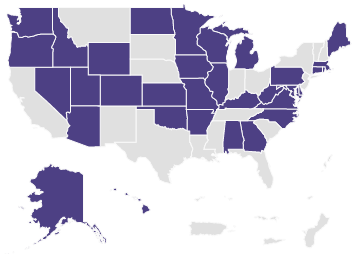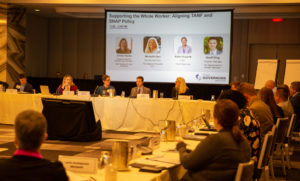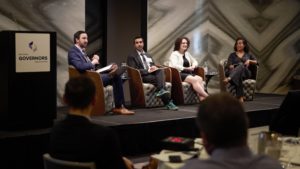State workforce development boards and agencies play a crucial role in driving innovation and best practices that lead to better educational and employment outcomes for their constituents.
by Rachael Stephens

On March 16th through the 19th, NGA hosted a bi-annual convening of state workforce development system leaders in Washington D.C. to discuss best practices, common challenges, emerging solutions and bipartisan federal priorities in workforce development. Representatives of 29 states and the District of Columbia participated in the event.
State leaders had a wide-ranging discussion with peer states and subject matter experts on a number of issues, such as:
- The short- and long-run impacts of major macroeconomic trends on workers and employers, including the implications for workforce developers
- Policy and program coordination with Temporary Assistance for Needy Families and the Supplemental Nutrition Assistance Program to support employment outcomes for participants
- Supporting employers in adopting skills-based hiring and other practices to improve diversity, equity and inclusion in workplaces and improve employment outcomes
- Developing innovative, outcomes-based financing models that support training at no up-front cost to workers
- Advancing apprenticeship and youth apprenticeship
- Recruiting and retaining a robust healthcare workforce
- Providing postsecondary education for formerly incarcerated individuals
- Shared interests and priorities with two other national membership organizations, the National Association of State Workforce Agencies and the National Association of Workforce Boards

Each topic was approached with a focus on how Governors and the workforce development systems they oversee can leverage the strategies discussed to address pressing workforce shortages, advance equity and access to opportunity, and stabilize long-term talent pipelines for employers.
Participating states also had a unique opportunity to engage in two closed-door discussions with federal representatives on Friday, March 18th: One with a panel of Biden Administration officials from the White House, U.S. Department of Transportation, and U.S. Department of Labor on partnering to implement workforce development provisions in the Infrastructure Investment and Jobs Act (IIJA), and another with congressional staff from the House Committee on Education and Labor and the Senate Committee on Health, Education, Labor and Pensions on governors’ and states’ priorities for reauthorization of the Workforce Innovation and Opportunity Act (WIOA), a draft of which was released by House Democrats not long after the convening.

During the IIJA panel, workforce system leaders expressed an eagerness to partner within their states and with federal partners in support of the new law, and the group identified opportunities for federal agencies to assist in these efforts as well. Attendees also identified opportunities for ongoing partnership during the session, such as partnering to develop informative resources on workforce development opportunities in the law, providing forums for more direct information-sharing between federal officials and states, and the sharing of sample memoranda of understanding and other sample or template materials developed by federal agencies to help state leaders more easily facilitate in-state partnerships.
During the Congressional panel, committee staff from both parties shared information with states about where their committee leadership stood on WIOA reauthorization priorities and what the path forward for reauthorization might look like. States also used this forum to share candid, bipartisan priorities, concerns and feedback with Hill staff that reflected several shared priorities raised during a closed-door discussion with leaders of the National Association of Workforce Boards and the National Association of State Workforce Agencies the day before. These included calls for increased federal funding and less year-to-year funding volatility so that programs can deliver results, and for greater flexibility in use of funds so that each state can respond to rapid shifts in labor markets, innovate, and target resources where they’re most needed in different regions. Other concerns raised included a need for greater flexibility over local workforce development area designation and the implications of a Wagner-Peyser merit staff rule change recently proposed by USDOL.
Partnership was a theme that surfaced throughout the convening, both in the context of the role the state workforce development system plays in connecting training, education, labor and industry stakeholders, and in terms of partnering as a collective with federal offices and national organizations through NGA. The discussions throughout the convening underscored the crucial role state workforce development boards and agencies can play in driving innovation and best practices that lead to better educational and employment outcomes for their constituents. Participants left with best practices and new ideas to take home to their states, as well as stronger connections with state peers and national partners, and an unmatched opportunity to share direct feedback with national policymakers and advance their Governors’ priorities in workforce development.
These bi-annual convenings are hosted by staff of NGA’s Workforce Development & Economic Policy program as part of its Workforce Development Technical Assistance Program, and convene two affiliates of the NGA Center for Best Practices: the National Association of State Workforce Board Chairs and the National Association of State Liaisons for Workforce Development Partnerships .
The next bi-annual NGA Workforce Symposium will be hosted in Oklahoma City, Oklahoma in August of 2022. For more information about the Workforce Development Technical Assistance Program or the affiliate associations, please contact Rachael Stephens at rstephens@nga.org.












